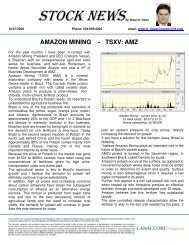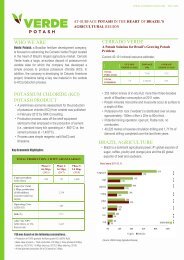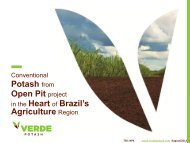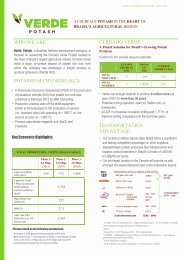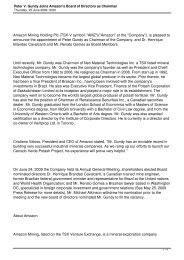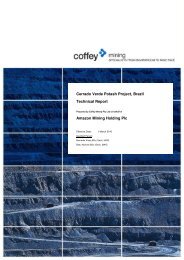NI 43-101 Preliminary Economic Assessment - Verde Potash
NI 43-101 Preliminary Economic Assessment - Verde Potash
NI 43-101 Preliminary Economic Assessment - Verde Potash
Create successful ePaper yourself
Turn your PDF publications into a flip-book with our unique Google optimized e-Paper software.
<strong>Verde</strong> <strong>Potash</strong> Plc 12-3<br />
Cerrado <strong>Verde</strong> Project<br />
<strong>NI</strong> <strong>43</strong>-<strong>101</strong> <strong>Preliminary</strong> <strong>Economic</strong> <strong>Assessment</strong><br />
12.1.4 Variography<br />
Introduction<br />
Variography is used to describe the spatial variability or correlation of an attribute. The spatial<br />
variability is traditionally measured by means of a variogram, which is generated by determining<br />
the averaged squared difference of data points at a nominated distance (h), or lag (Srivastava and<br />
Isaacs, 1989). The averaged squared difference (variogram or v(h)) for each lag distance is<br />
plotted on a bivariate plot, where the X-axis is the lag distance and the Y-axis represents the<br />
average squared differences (v(h)) for the nominated lag distance.<br />
Several types of variogram calculations are employed to determine the directions of the<br />
continuity of the mineralization:<br />
Traditional variograms are calculated from the raw assay values;<br />
Log-transformed variography involves a logarithmic transformation of the assay data;<br />
Gausssian variograms are based on the results after declustering and a transformation to a<br />
Normal distribution;<br />
Pairwise-relative variograms attempt to 'normalize' the variogram by dividing the<br />
analyses; and<br />
Correlograms are 'standardized' by the variance calculated from the sample values that<br />
contribute to each lag.<br />
Fan variography involves the graphical representation of spatial trends by calculating a range of<br />
variograms in a selected plane and contouring the variogram values. The result is a contour map<br />
of the grade continuity within the domain.<br />
The variography was calculated and modeled in the mining planning software, Gemcom Surpac<br />
Software. The rotations are tabulated as input into Gemcom Surpac Software (geological<br />
convention), with X representing the bearing, Y representing dip and Z representing plunge. Dip<br />
and dip direction of major, semi-major and minor axes of continuity are also referred to in the<br />
text.<br />
Grade variography was generated to enable grade estimation via OK. Interpreted anisotropy<br />
directions correspond well with the modeled geology and overall geometry of the interpreted<br />
domain. The results are show in Table 12.1.4.1.<br />
Table 12.1.4.1: Cerrado <strong>Verde</strong> Deposit Unweathered and Weathered Mineralized Domain<br />
Variogram Models<br />
K2O<br />
Nugget<br />
(CO)<br />
Bearing<br />
Rotation Structure 1 Structure 2<br />
Dip Plunge<br />
Sill 1<br />
(C1)<br />
Major<br />
Range (m)<br />
Semi-<br />
Major Minor<br />
Sill 2<br />
(C2)<br />
Major<br />
Range (m)<br />
Semi<br />
Major Minor<br />
Low Grade 0.21 180 -10 0 0.34 200 100 16.53 1.20 400 200 33.06<br />
High Grade 0 21 180 -10 0 0.34 200 100 16.53 1.20 400 200 33.06<br />
SRK Consulting (U.S.), Inc. September 16, 2011<br />
Cerrado <strong>Verde</strong>_<strong>NI</strong> <strong>43</strong>-<strong>101</strong> PEA_3<strong>43</strong>500.020_007_KG




